 Unlimited in every sense, the new series production Exige Cup 430 is Lotus’ wildest incarnation of its fire-breathing, point-to-point two-seater sports car.
Unlimited in every sense, the new series production Exige Cup 430 is Lotus’ wildest incarnation of its fire-breathing, point-to-point two-seater sports car.
New to the Exige, the Cup 430 sees the introduction of a savage, high-performance engine installation, mated to a new supercharger and chargecooler, designed specifically for the unique demands of this vehicle. A development of the powertrain recently used on the phenomenal Lotus Evora GT430, it’s perfectly paired with a newly-designed body, which delivers enhanced aerodynamic performance to reveal the model’s true potential. The result is a strikingly different beast of pure performance, that’s not for the faint of heart.
• New engine installation, delivering 430 hp and 440 Nm
• New design generating 220 kg of downforce
• 407 hp per tonne provides unrivalled performance
• 0-60 mph in 3.2 secs, dry weight from 1,056 kg
With 55 hp, or 13%, more power than the limited production Exige Cup 380 model it succeeds, and 220 kg of downforce, it’s a monster of a car. Compared to the Exige Sport 350, it has 24% more power and generates the same downforce at 100 mph as the Exige Sport 350 does at its maximum speed of 170 mph.
Lotus’ expertise in lightweight design has played its part in reducing the overall dry weight by 12 kg to 1,059 kg, with the vehicle down to 1,056 kg in its lightest configuration. This, combined with the dramatic jump in raw power, raises the Cup’s power to weight from 355 hp / tonne (Cup 380) to 407 hp / tonne.
 With 430 hp at 7,000 rpm and 440 Nm (325 lbft) of torque from 4,000 rpm, 0-60mph is dispatched in 3.2 seconds (0-100 km/h in 3.3 seconds) with a top speed of 180 mph (290 km/h). Helping to harness all that power, the Cup 430 benefits from a comprehensive range of new aero elements. A new ultra-lightweight front clam with unique carbon fibre ducts has wider radiator apertures and a new mesh pattern grille to provide a more combative aspect and to allow for a new front splitter and air curtain mechanism to reduce drag. The lightweight rear clam panel supports the larger, straight motorsport wing to increase downforce without impacting upon the car’s overall drag coefficient. The new design front and rear clam panels are 6.8 kg lighter than those on any other Exige.
With 430 hp at 7,000 rpm and 440 Nm (325 lbft) of torque from 4,000 rpm, 0-60mph is dispatched in 3.2 seconds (0-100 km/h in 3.3 seconds) with a top speed of 180 mph (290 km/h). Helping to harness all that power, the Cup 430 benefits from a comprehensive range of new aero elements. A new ultra-lightweight front clam with unique carbon fibre ducts has wider radiator apertures and a new mesh pattern grille to provide a more combative aspect and to allow for a new front splitter and air curtain mechanism to reduce drag. The lightweight rear clam panel supports the larger, straight motorsport wing to increase downforce without impacting upon the car’s overall drag coefficient. The new design front and rear clam panels are 6.8 kg lighter than those on any other Exige.
Focused fairly and squarely on aggressive track performance and point-to-point supremacy, the new Lotus Exige Cup 430 is capable of covering the Hethel circuit in 1 minute 24.8 seconds – the fastest production car to lap the famous circuit – 1.2 seconds faster than the Lotus 3-Eleven (Road).
Jean-Marc Gales, CEO, Group Lotus plc said, “This is the car that we have always wanted to build, and I am sure that all Lotus enthusiasts will be delighted with the end product. As well as a significant power hike, the Cup 430 has benefited from extensive development in areas essential to Lotus’ DNA, in order to ensure that the full potential of the Exige’s incredible chassis can be exploited. This car has no rivals – inside or outside of its price bracket – and it’s no exaggeration when we say that nothing can keep up with this Exige on the road or track.”
Lotus’ most extreme Exige packs the company’s most potent powertrain into its smaller vehicle architecture to provide a level of performance that is a step beyond what most drivers can exploit. The car’s distinctive and aggressive new styling perfectly matches the character of the new Exige Cup 430.
Signalling the most motorsport focused models in Lotus’ range, the Cup variants are centered on only the essential. Extending this philosophy to its limit, the new Cup 430 is at the apex of the Exige line-up – with only a track-only racer capable of exceeding the car’s abilities.
With the Exige already regarded as the standard for purity of purpose, Lotus’ engineers have built upon this benchmark, ensuring that the application of more power is complemented by a class-leading handling balance, characterised by precision and tactility.
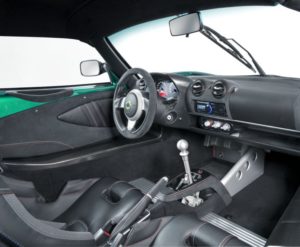
At the heart of the car lies Lotus’ most formidable engine, a 3.5-litre supercharged and charge cooled V6 producing 430 hp and 440 Nm.
Unapologetically aggressive, the Exige Cup 430’s 220 kg of downforce is developed through the careful management of airflow under and over the car. Vital in keeping the Cup at the top of timing sheets, it’s designed to make the most of 440 Nm (325 lbft) of torque delivered from 4,000 rpm, and delivering the lowest of lap times not matter the track. This not only includes the new front clam panel, incorporating a new design of splitter and carbon fibre air blades, but also the high mounted rear wing. The new body introductions combine form and function, with the new hybrid carbon composite panels not only saving weight, but also delivering the car’s distinctive new styling and aerodynamic set up.
Balancing downforce over the entire car was a priority with, when compared to the Exige Cup 380, a greater percentage of downforce allocated to the front to ensure accurate high-speed turn in (36% increased to 45%). The new front splitter with trailing lip helps separate and speed airflow under the car and the inclusion of new air curtain elements into the front clam panel efficiently moves air though to the front wheel cavities to help reduce turbulence and drag generated by the front wheels. The front louvers reduce the pressure within the front wheel arches, increasing downforce. The cut-out sections behind the rear wheels, also reduce wheel arch pressure, whilst the new lightweight aluminium diffuser is 1 kg lighter. Crowning all of this is the carbon fibre straight rear wing, raised higher to further boost downforce, clearly signaling the car’s aggressive intent and pursuit of aerodynamic excellence.
As you would expect, the intense use of ultra-lightweight carbon fibre only adds to the overall performance, as well as reinforcing the Exige Cup 430’s physical presence. The hand-made composite components include front splitter, front access panel, roof, diffuser surround, large aperture air-intake side pods, one-piece tailgate and the race derived rear wing.
Scratch the surface of the Cup’s capabilities, and you’ll find its motorsport-derived credentials. In addition to revised steering arm geometry, to increase bump steer, the car’s handling characteristics can be altered via the introduction of new Nitron three-way adjustable dampers (adjustable for rebound and low and high-speed compression, giving the ability to fine tune the damping) and Eibach adjustable front and rear anti-roll bars, both as standard.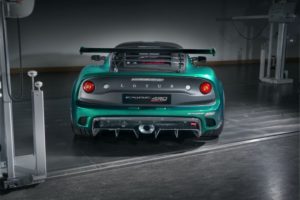
The substantial Michelin Pilot Sport Cup 2 tyres (215/45 ZR17 front and 285/30 ZR18 rear) are fitted to ultra-lightweight forged alloy wheels, available in red, black or silver as standard.
The faster the car, the better the brakes need to be, and the Exige Cup 430 uses some of the largest calipers and rotors of any Lotus road car. With forged, four-piston AP Racing brake calipers and new performance two-piece, J-hook brake discs (with higher thermal capacity) front and back, the system is designed to give improved bite and debris clearance and reduce distortion and vibration and to deliver consistent pedal feel and stopping power lap after lap.
The Cup 430 also comes with a tremendously strong, yet light, T45 steel roll over bar, new seatbelt anchorage frame (saving 1.2 kg), a Lithium-Ion battery and front towing eye as standard, as well as a host of options including, a dealer fit FIA compliant roll cage, electrical cut-off and fire extinguisher controls, airbag deletion and a non-airbag steering wheel.
Key to the Cup’s potency is the Exige’s newly-developed powertrain. Based on the benchmark engine from the recently launched Evora GT430, it features an Edelbrock supercharger and water to air charge cooler to generate more power through cooling the higher pressure charged intake air. Specifically developed for the Exige, the engine’s calibration allows for a redline of 7,000rpm, helped in part by a new intake system and larger throttle body. In order to handle the extra power, a new oil cooler configuration and uprated clutch are required.
Available as standard with a close-ratio, six-speed manual transmission, the Exige range features Lotus’ acclaimed open-gate manual gearbox design. Precisely aligned for fast and seamless shifts, it has recently established itself as a favourite of Lotus customers. To transfer the increased power and torque from the engine to the gearbox, a new 240 mm diameter clutch has been fitted (up 12 mm compared to the Exige Cup 380) which increases the clutch surface area by 11%.
Engine note and tone also play big parts in the Cup’s repertoire. With the new induction and supercharger configuration, and a high-flow titanium exhaust system as standard, the Cup 430 sounds like no other Exige at speed. In addition, the titanium exhaust removes 10 kg from beyond the rear axle.
The Lotus Exige Cup 430 includes a variable traction control function, linked directly to the ECU. The six-position rotary switch is located on the steering column, and only active with ESP switched to off, with five pre-set traction levels (1%, 3%, 6%, 9%, 12% slip) as well as “off”, displayed via the instrument cluster.
The composite concept continues into the Cup’s cabin with visible-weave, handmade sections including a new lightweight carbon fibre binnacle surr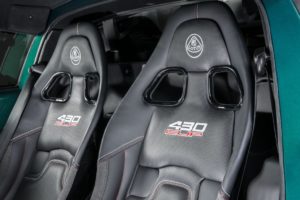 ound, Lotus’ bespoke carbon race seats, with new lightweight seat runners, and carbon door sills. Colour keyed inserts for the revised lightweight sports seats, transmission console, HVAC surround and window switches are also standard, along with a centre console, door cards and dashboard trimmed in Alcantara®, with leather or tartan as a no cost option, along with contrast stitching and an Alcantara® steering wheel. In total, the lightweight interior of the Exige Cup 430 is 2.5 kg lighter than on the Cup 380.
ound, Lotus’ bespoke carbon race seats, with new lightweight seat runners, and carbon door sills. Colour keyed inserts for the revised lightweight sports seats, transmission console, HVAC surround and window switches are also standard, along with a centre console, door cards and dashboard trimmed in Alcantara®, with leather or tartan as a no cost option, along with contrast stitching and an Alcantara® steering wheel. In total, the lightweight interior of the Exige Cup 430 is 2.5 kg lighter than on the Cup 380.
All the lightweight standard items help reduce the total mass by 29 kg which more than offsets the increase in weight from the chargecooler and cooling system (+15 kg), new higher rated clutch (+0.8 kg) and wider brake discs (+1.2 kg) resulting in an unladen weight of 1,093 kg and 1,059 kg dry. By selecting the airbag deletion option, the customer can take the lightest possible dry weight of the Exige Cup 430 to 1,056 kg.
For owners wanting to brand the new Exige their own, the Cup 430 can be personalised through Lotus’ Exclusive programme. Combining traditional British craftsmanship with modern design, the service inspires customers to spend time tailoring the character of their Lotus with a comprehensive array of options. Since its introduction this has proved increasingly popular, with over 25% of all new cars undergoing some form of personalisation.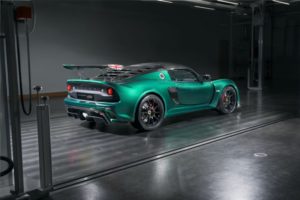
Launching the new Lotus, Jean-Marc Gales said, “The Exige continues to push the boundaries of what is possible in terms of performance, agility, aerodynamics and rapid covering of ground from A to B in a production road car. There isn’t another car on sale that can match the new Exige Cup 430; it will go down as a ground-breaking car in the history of Lotus.”
The Exige Cup 430 is available as a series production car and can be ordered now, priced £99,800 including VAT (UK) and €127,500 (Germany) and €128,600 (France).
Here at AIB we offer exceptional bespoke insurance cover for Lotus owners and understands that owning and driving a Lotus is a unique experience and deserves one-of-a-kind insurance call us now on 02380 268351 for your Lotus insurance!

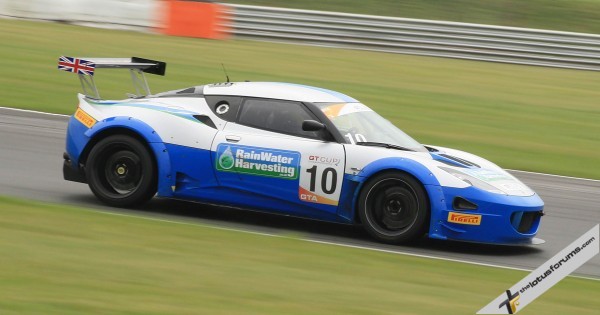 Although it was over a month since the pairing of Adrian Lester and his pro driver and coach, Andrew Bentley had driven the Evora, they were hopeful to pick up where they had left off all those weeks ago at Silverstone, where despite failing to finish the weekend’s races due to a suspension failure thanks to contact, they had set fastest times in their class and were looking to be in a good position to put in a strong result. “Silverstone was disappointing on one hand but on the other it hinted at the potential we have in the car and the driver pairing. We went into Silverstone with a healthy lead in our class in and an incredible 4th position in the overall Championship standings, sadly, this was not to last. Adrian had the strongest run of his season in qualifying and it was looking great for the race. Sadly, a hangover from some contact earlier caused the suspension to give up and the team, despite a big effort, were unable to fix it for the races.” Said Andrew
Although it was over a month since the pairing of Adrian Lester and his pro driver and coach, Andrew Bentley had driven the Evora, they were hopeful to pick up where they had left off all those weeks ago at Silverstone, where despite failing to finish the weekend’s races due to a suspension failure thanks to contact, they had set fastest times in their class and were looking to be in a good position to put in a strong result. “Silverstone was disappointing on one hand but on the other it hinted at the potential we have in the car and the driver pairing. We went into Silverstone with a healthy lead in our class in and an incredible 4th position in the overall Championship standings, sadly, this was not to last. Adrian had the strongest run of his season in qualifying and it was looking great for the race. Sadly, a hangover from some contact earlier caused the suspension to give up and the team, despite a big effort, were unable to fix it for the races.” Said Andrew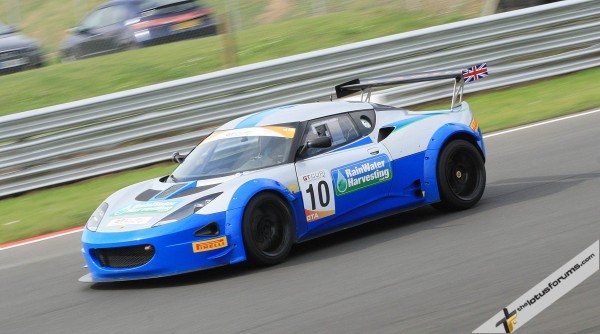 Traces, each 25 minutes long. No driver changes in either of these so they are flat out duels to the flag. As has been the case in the previous rounds, Adrian drove in the first of these, round 11 of the championship, with Andrew taking the wheel for the second race later in the day, round 12.
Traces, each 25 minutes long. No driver changes in either of these so they are flat out duels to the flag. As has been the case in the previous rounds, Adrian drove in the first of these, round 11 of the championship, with Andrew taking the wheel for the second race later in the day, round 12.
You must be logged in to post a comment.